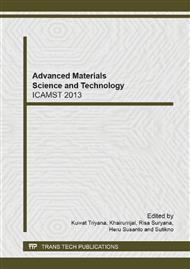p.45
p.49
p.54
p.58
p.62
p.66
p.70
p.74
p.78
Epoxidised Natural Rubber Based Polymer Electrolyte Systems for Electrochemical Device Applications
Abstract:
Epoxidized Natural Rubber (ENR50), lithium imide salt, [LiN(SO2CF3)2] with and without solvent were prepared by solvent casting technique. Non solvated polymer electrolyte showed modest ionic conductivity at ambient temperature. To further enhance ionic conductivity a mixed solvent of ethylene carbonate/propylene carbonate was added into the system. Thermal characterization showed that single transition glass temperature (Tg) for all systems and amorphous phase is dominant. DSC traces of non solvated samples have shown Tg values increased whereas addition of mixed EC/PC solvent into the electrolyte system reduced their values respectively. Impedance measurements for the solvated epoxidized natural rubber (ENR) based electrolyte systems have shown optimal ionic conductivity 10-4 S cm-1 whereas 10-6 S cm-1 for a non solvated one. ENR electrolyte systems showed similar temperature dependence, which suggests that the conductivity is thermally activated.
Info:
Periodical:
Pages:
62-65
Citation:
Online since:
February 2014
Authors:
Price:
Сopyright:
© 2014 Trans Tech Publications Ltd. All Rights Reserved
Share:
Citation:


